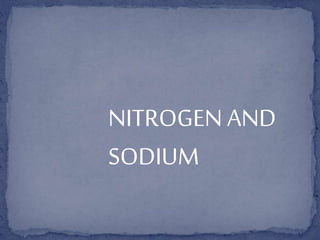
N2 and Na properties
- 2. NITROGEN Nitrogen is a chemicalelementthathas the symbol N, atomicnumber of 7 and atomicmass 14.000 u. Elemental nitrogenis a colorless, odorless, tasteless and mostly inert diatomic gas at standard conditions, constituting78% by volume of Earth'satmosphere.
- 3. Many industriallyimportant compounds, such as ammonia, nitricacid, organic nitrates (propellants and explosives), and cyanides, containnitrogen.The extremely strong bond in elementalnitrogendominates nitrogenchemistry, causing difficulty for both organisms and industry in breaking the bond to convert the N2 into usefulcompounds, but releasing large amountsof often usefulenergy, whenthesecompounds burn, explode, or decay back into nitrogengas.
- 4. salient features: It has a high electronegativity(3.4 on the Pauling scale), and when you have neutralcharge, 5 electronsin the outermost level, behaving as trivalentmost stablecompounds thatform.
- 5. Applications The most importantcommercial application of diatomic nitrogenis obtainingammoniaby the Haber process. Ammonia is subsequentlyused inthe manufactureof fertilizers and nitricacid. Nitricacid salts include important compounds such as potassium nitrate(saltpeter or nitrateused inmaking gunpowder) and ammoniumnitrate fertilizer.
- 6. The organic nitrogencompounds such as nitroglycerin and trinitrotolueneare often explosive. Hydrazine and its derivatives are used as rocket fuel. Being a very reactive gas, nitrogenis used industrially to create as protective atmospheres and cryogenic gas for temperaturesof 78K easily and inexpensively.
- 7. Occurrence Nitrogen is the main component of Earth's atmosphere (78.% by volume) and for industrial use is obtained from the distillation of liquid air. It is also present in the remains of animals, such as guano, usually in the form ofurea, uric acid and both compounds. It is also the 3% of the elemental composition of the human body. Have beenobserved nitrogen-containing compounds in outer space and the isotope nitrogen-14 is createdin nuclear fusion processes of stars.
- 8. PHYSICALAND CHEMICALPROPERTIES In its naturalstateas a diatomic gas is odorless, colorless, tasteless and nontoxic. The bond between two nitrogen atoms is very stable,which explains thatin a relatively stablemolecular state,however, the atomic nitrogen reacts withease.
- 9. It is an inert gas, nonmetal, colorless, odorless and tasteless, which makes up about four-fifths of atmospheric air, although not involved in combustion or respiration. It has a high electronegativity (3 in the Pauling scale) and 5 electrons in the outermost level behave as trivalent in most compounds thatform.
- 10. Sodium Sodium isa chemical element with symbol Na (Latin natrium) and atomic number 11, wasdiscovered by Sir Humphry Davy. Alkali metal isa soft, creamy, silvery, very abundant in nature, found in sea saltand the mineral halite. It is highly reactive, burns with yellow flame, oxidizes in the presence of oxygen and reacts violently with water.
- 11. Key Features Likeother alkalimetal sodium is a soft, silvery light that is not found free in nature. Sodium decomposing it floats in water, releasing hydrogen and forming a hydroxide. Under appropriate conditions react spontaneously in water. Normally not burn on contact with airbelow 40 ° C.
- 12. Use ofsodium Sodium metal is used in organic synthesis asa reducing agent. It is also a component of sodium chloride necessary for living. Other uses are: • In antifriction alloys (gold). • In the manufacturing of deodorants (in combination with fatty acids). • In the purification of molten metals.
- 13. • The Na K alloy, amaterial used for heat transfer aswell asdesiccant for organic solvents and asa reductant. Is liquid atroom temperature. Sodium isalso used ascoolant. • Lead Alloyis used in the manufacture of detonating additive for gasoline. • It is also used in the manufacture of photoelectric cells. • Lighting by sodium vapor lamps.
- 14. Abundance Sodium is relatively abundantin stars, detectingits presence across the solar spectrum D line,located approximately in the yellow. The earth'scrust contains about 2.6% of sodium,which makes it thefourth most abundantelement,and the most abundantof the alkali metals.
- 15. Today is produced by electrolysis of moltensodium chloride, cheaper procedure thanthe onepreviously used, theelectrolysis of sodium hydroxide. Alkali metalis thecheapest. The most abundantcompound of sodium is sodium chloride or common salt, but is also present in various mineralslike haliteand zeolites.